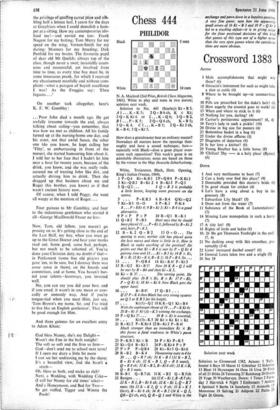Chess 444
PHILIDOR
N. A. Macleod (2nd Prize, British Chess Magazine, 1961). White to play and mate in two moves; solution next week.
Solution to No. 443 (Searley): Kt - B 5.
A 1 K - K 5; 2 Q - B 6 ch, K x Kt; 3Q-KKt 6 or 2...K-Q 6; 3Q-B2.
B 1 P-K 5; 2 Q-Q 6ch, K-B 5; 3 Q-K 4. Cl...K-B 5; 2 Q-Kt 3 ch, K - B 4; 3 Q - Kt 5.
How does a grandmaster beat an ordinary master? Nowadays all masters know the openings thor- oughly and have a sound technique; how— especially with Black—does a great player over- come such opposition? This week's game is an admirable illustration; notes are based on those by the winner in the May Deutsche Schachzeitung.
White, Troianescu. Black, Hort. Opening, King's Indian (Venice, 1969).
1 P-Q4 Kt-KB3 2P-QB4 P-KKt3 3 Kt-QB3 B-Kt 2 4 B-Kt5 P-Q3 5 Q-Q 2 ... 5 Q- B 2 is probably a little better, keeping more pressure on the centre.
5 , P-KR3 6 B-R4 QKt-Q2 7 Kt -B3 0-0 8 P - K 3 P-K 4 8... P- 1CKt 4; 9 B - Kt 3; Kt - R 4 is a good alternative.
9 P x P P x P 10 R-Q1 R-Kl
11 Q-B2 P-B3 Hort says that he should have played II P - Kt 3; followed by B -Kt 2 and, later, P - K 5.
12 B - K 2 Q - El 2 13 0 - 0 . . . The opening is over; neither side has played quite the best moves and there is little in it. How is Black to make anything of the position? He points out that Kt - B 4 is met by P - Q Kt 4 gaining time and 13 . . .Kt - B I by 14 B x Kt, B x B; 15 Kt -K 4,B-K 2; 16 P-B 5.So...
13 ... P-QR4 14 Kt-R4! P-Kt3
15 R-Q 2 Kt -B1! Now 16KR-Qlwill be met by B - B4 and then Kt -K 5.
16 Kt - B 3? . . . The turning point. He should play 16 B x Kt, B x B; 17 P - B5,
P - Q Kt 4; 18 Kt - Kt 6 Now Black gets the upper hand.
16 ... B-B4! 17 Q-B1
If 17 P - K 4 then Black has very strong squares on Q 5 or K B 5 for his knight.
17 ... Kt(1)-Q2 18KR-Q1 Kt-B4 With the unpleasant threat of 19 P -K Kt 41
20 B - Kt 3: Kt (3)- K 5 winning the exchange.
19 P - Q Kt 3? . 19 B x Kt is essential.
19 . . . Kt (3)-K 5 20 Kt x Kt Kt x Kt
21 R-Kt 2 P-KKt4 22B-Kt3 P-R4! Much stronger than an immediate Kt x BI this forces a fatal weakness in White's pawn structure.
23 P-KR 3 Kt x B 24 P x Kt P-K 5 25 Kt-Q4 B-Kt 3 26P-KKt4 P x P
27 P x P P-QB4 28 Kt-Kt 5 Q-Kt 6
29 R-B2 B-K4 Threatening mate in 4 by 30 . . . Q - R 7 ch; 31 K - B I (31 K - B 2, B - Kt 6 ch; 32 K - B 1, Q - R 8 mate), Q-R 8 ch; 32 K - B 2,B-Kt 6 chl; 33 KXB,
Q - R 5 mate.
30 B-B1 Q-R7ch 31K -112 Q-R5ch
32 Resigns . . . (a) 32 K - Kt 1, B -R 7 ch; 32 K - R I, B - Kt 6 ch; 33 K - Kt I, Q - R 7 mate. (b) 32 K- K 2, Q x P ch; 33 K- K I (best), B - Kt 6 eh; 34 R - B 2 (34 K - Q 2, QR- Q1 ch, etc), Q R- Q 1 and White is the exchange and pawn down In a hopeless position. A very fine game; note how the apparently small errors of 16 Kt - B 3 and 19 P - Q Kt 3 led to a crushing defeat—it is in giving scope for the finer positional decisions of this kind that games of this type are of a higher order than the very open games where the considers. lions are more obvious.






































 Previous page
Previous page